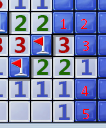In general, when looking at these situations, you want to click on the squares that are the least likely to contain mines. This will invariably give you more information about your current situation.
Here's an example of a game that can't be beaten without strict testing, which I will use to demonstrate what I mean.

There are two mines remaining. I apologize, but the 3 underneath the square labeled 2 actually has two adjacent flags, and needs one more flag; one of them was cut off in the screenshot.
Because there is a 1 next to 1 and 2, I know that one of these must be a mine. If 1 is a mine, then 2 is not, which means one of 4, 5, 6 is a mine, and 3 is not. This gives three cases when 1 is a mine.
If 1 is not a mine, then 2 is a mine. If 2 is a mine, then none of 4, 5, 6 is a mine, which means 3 must be a mine. This has only one case.
Therefore, the number of cases where 1 is a mine is 3/4; the number of cases where it is not is 1/4. We can proceed assuming that 1 is a mine - and as it happens to turn out, it is.

Here's another example of a possible setup. The method I use in these cases effectively can be extended across the entire board (which makes it a bit more accurate), but I only execute it a few levels in my head. Here's how my thought process works:
We can see that if 5 is a mine, then 4 can't be, which means 3 is. At this point, either 1 or 2 could be a mine, which gives two cases.
If 5 isn't a mine, then 4 must be a mine, which means 3 isn't, which means both 1 and 2 are - which gives one case.
Therefore, the situation in which 5 is a mine covers 2/3 of the cases, and the situations in which 5 isn't covers 1/3. Therefore, we proceed on the assumption that 5 is a mine.
Of course, there are more than three cases for the entire grid - this is only a rough estimate. I could go into further detail about what the squares above 1 and 2 could be, as well as the surrounding squares, but I won't here. It all depends on how long you want to take and how accurate you want to be.


